Monitoring and Development in Health and Social Care Settings Report
VerifiedAdded on 2020/01/28
|7
|1956
|162
Report
AI Summary
This report delves into the critical aspects of employee performance monitoring and development within health and social care settings. It explores various strategies for assessing employee performance, including regulatory inspections, patient surveys, third-party assessments, and statistical indicators. The report highlights the importance of a structured performance management framework, emphasizing clear objectives, communication, defined responsibilities, and reward systems. It further examines methods for identifying individual training and development needs, advocating for a systematic approach that includes re-evaluating business goals, addressing critical activities, and assessing problem domains. The report underscores the significance of performance feedback, incentives, and tailored training opportunities in fostering continuous employee development and enhancing the quality of care. The report also includes the importance of providing training and developmental opportunities to the employees to enhance their skills and improve their performance.
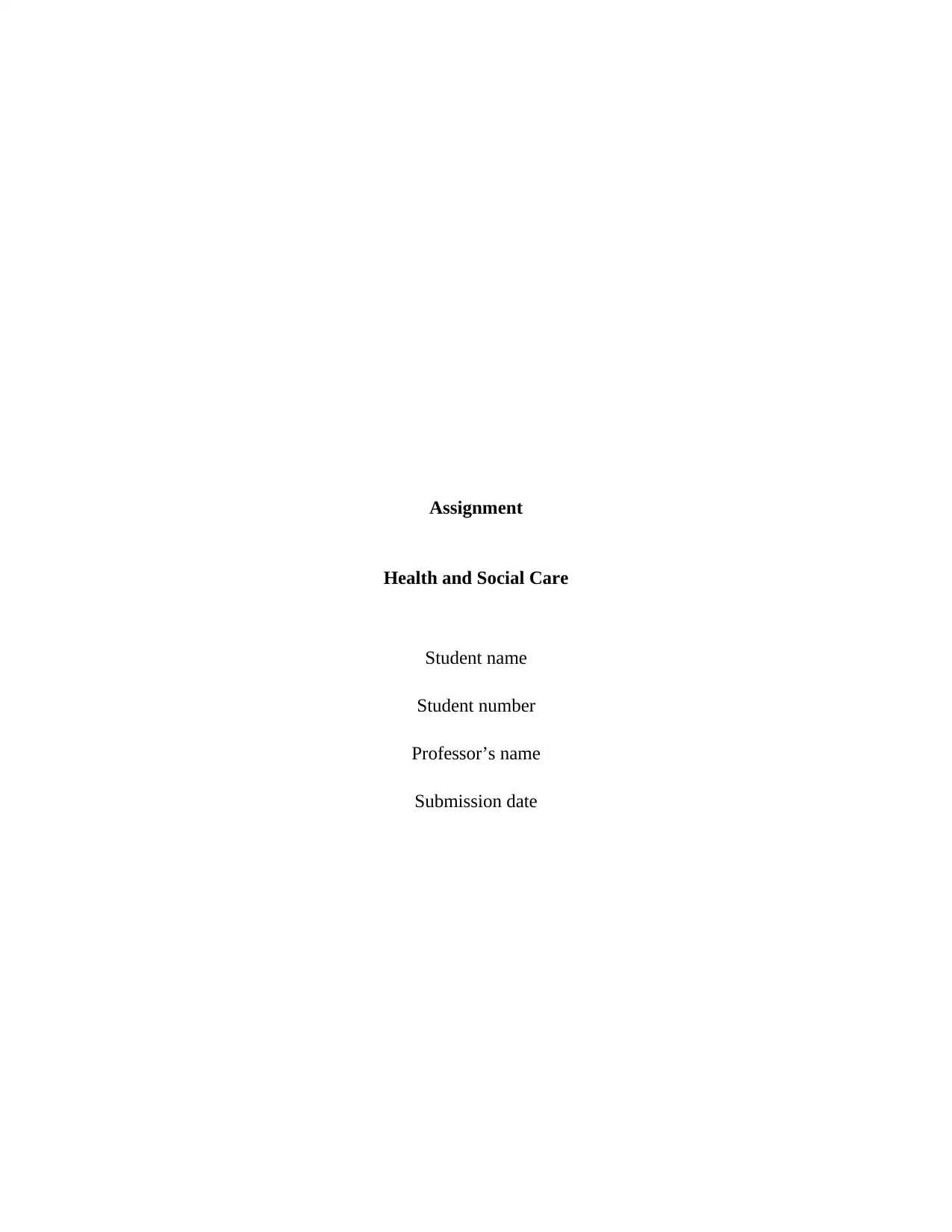
Assignment
Health and Social Care
Student name
Student number
Professor’s name
Submission date
Health and Social Care
Student name
Student number
Professor’s name
Submission date
Paraphrase This Document
Need a fresh take? Get an instant paraphrase of this document with our AI Paraphraser
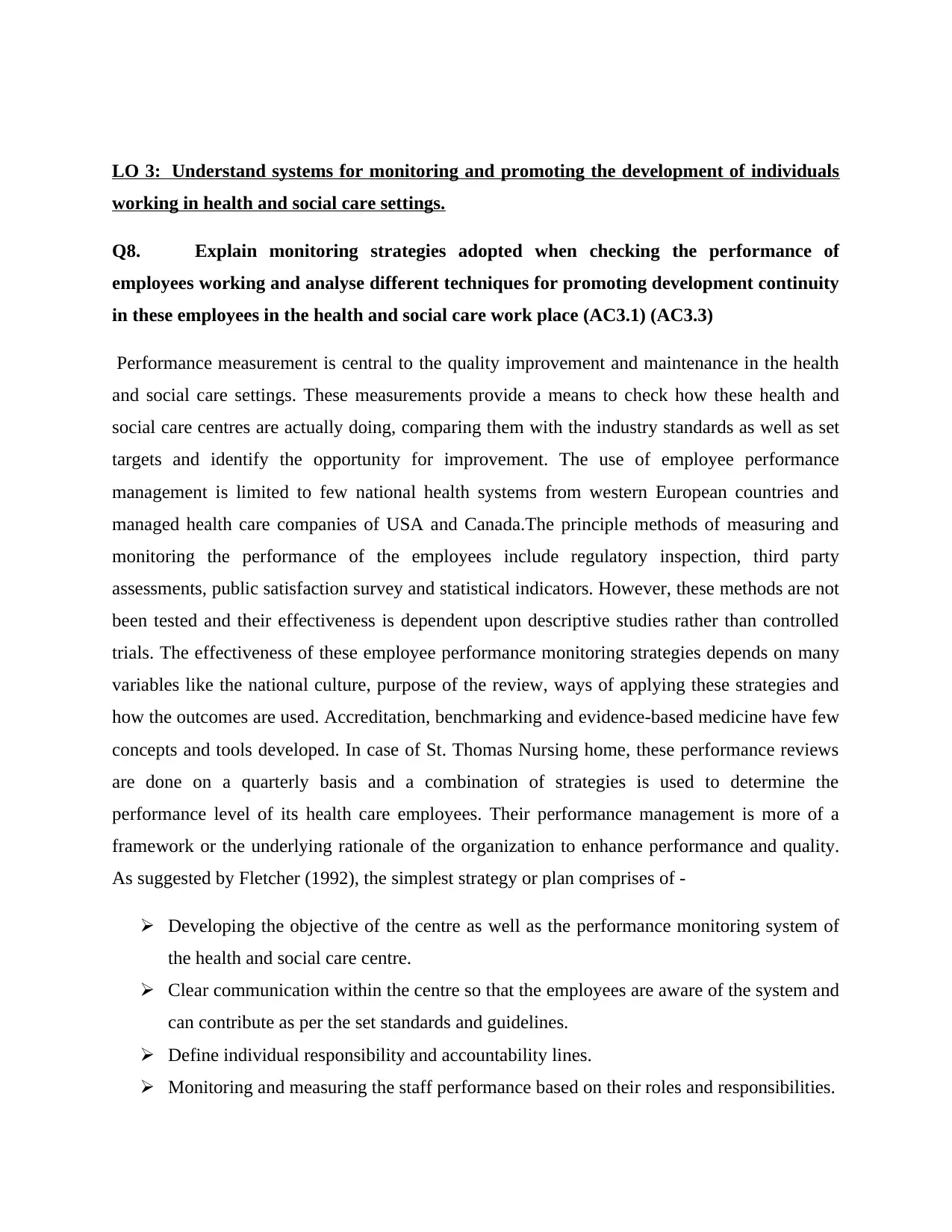
LO 3: Understand systems for monitoring and promoting the development of individuals
working in health and social care settings.
Q8. Explain monitoring strategies adopted when checking the performance of
employees working and analyse different techniques for promoting development continuity
in these employees in the health and social care work place (AC3.1) (AC3.3)
Performance measurement is central to the quality improvement and maintenance in the health
and social care settings. These measurements provide a means to check how these health and
social care centres are actually doing, comparing them with the industry standards as well as set
targets and identify the opportunity for improvement. The use of employee performance
management is limited to few national health systems from western European countries and
managed health care companies of USA and Canada.The principle methods of measuring and
monitoring the performance of the employees include regulatory inspection, third party
assessments, public satisfaction survey and statistical indicators. However, these methods are not
been tested and their effectiveness is dependent upon descriptive studies rather than controlled
trials. The effectiveness of these employee performance monitoring strategies depends on many
variables like the national culture, purpose of the review, ways of applying these strategies and
how the outcomes are used. Accreditation, benchmarking and evidence-based medicine have few
concepts and tools developed. In case of St. Thomas Nursing home, these performance reviews
are done on a quarterly basis and a combination of strategies is used to determine the
performance level of its health care employees. Their performance management is more of a
framework or the underlying rationale of the organization to enhance performance and quality.
As suggested by Fletcher (1992), the simplest strategy or plan comprises of -
Developing the objective of the centre as well as the performance monitoring system of
the health and social care centre.
Clear communication within the centre so that the employees are aware of the system and
can contribute as per the set standards and guidelines.
Define individual responsibility and accountability lines.
Monitoring and measuring the staff performance based on their roles and responsibilities.
working in health and social care settings.
Q8. Explain monitoring strategies adopted when checking the performance of
employees working and analyse different techniques for promoting development continuity
in these employees in the health and social care work place (AC3.1) (AC3.3)
Performance measurement is central to the quality improvement and maintenance in the health
and social care settings. These measurements provide a means to check how these health and
social care centres are actually doing, comparing them with the industry standards as well as set
targets and identify the opportunity for improvement. The use of employee performance
management is limited to few national health systems from western European countries and
managed health care companies of USA and Canada.The principle methods of measuring and
monitoring the performance of the employees include regulatory inspection, third party
assessments, public satisfaction survey and statistical indicators. However, these methods are not
been tested and their effectiveness is dependent upon descriptive studies rather than controlled
trials. The effectiveness of these employee performance monitoring strategies depends on many
variables like the national culture, purpose of the review, ways of applying these strategies and
how the outcomes are used. Accreditation, benchmarking and evidence-based medicine have few
concepts and tools developed. In case of St. Thomas Nursing home, these performance reviews
are done on a quarterly basis and a combination of strategies is used to determine the
performance level of its health care employees. Their performance management is more of a
framework or the underlying rationale of the organization to enhance performance and quality.
As suggested by Fletcher (1992), the simplest strategy or plan comprises of -
Developing the objective of the centre as well as the performance monitoring system of
the health and social care centre.
Clear communication within the centre so that the employees are aware of the system and
can contribute as per the set standards and guidelines.
Define individual responsibility and accountability lines.
Monitoring and measuring the staff performance based on their roles and responsibilities.
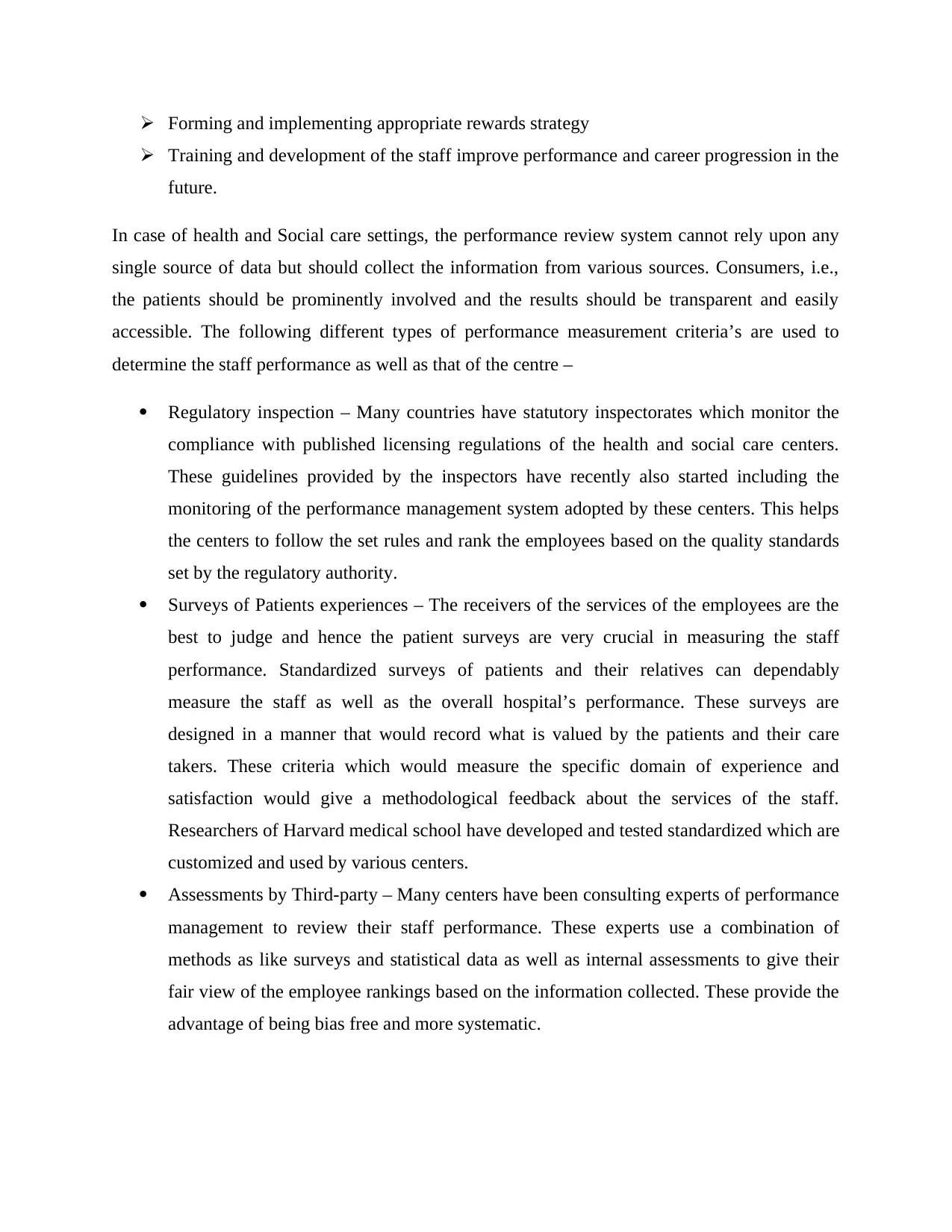
Forming and implementing appropriate rewards strategy
Training and development of the staff improve performance and career progression in the
future.
In case of health and Social care settings, the performance review system cannot rely upon any
single source of data but should collect the information from various sources. Consumers, i.e.,
the patients should be prominently involved and the results should be transparent and easily
accessible. The following different types of performance measurement criteria’s are used to
determine the staff performance as well as that of the centre –
Regulatory inspection – Many countries have statutory inspectorates which monitor the
compliance with published licensing regulations of the health and social care centers.
These guidelines provided by the inspectors have recently also started including the
monitoring of the performance management system adopted by these centers. This helps
the centers to follow the set rules and rank the employees based on the quality standards
set by the regulatory authority.
Surveys of Patients experiences – The receivers of the services of the employees are the
best to judge and hence the patient surveys are very crucial in measuring the staff
performance. Standardized surveys of patients and their relatives can dependably
measure the staff as well as the overall hospital’s performance. These surveys are
designed in a manner that would record what is valued by the patients and their care
takers. These criteria which would measure the specific domain of experience and
satisfaction would give a methodological feedback about the services of the staff.
Researchers of Harvard medical school have developed and tested standardized which are
customized and used by various centers.
Assessments by Third-party – Many centers have been consulting experts of performance
management to review their staff performance. These experts use a combination of
methods as like surveys and statistical data as well as internal assessments to give their
fair view of the employee rankings based on the information collected. These provide the
advantage of being bias free and more systematic.
Training and development of the staff improve performance and career progression in the
future.
In case of health and Social care settings, the performance review system cannot rely upon any
single source of data but should collect the information from various sources. Consumers, i.e.,
the patients should be prominently involved and the results should be transparent and easily
accessible. The following different types of performance measurement criteria’s are used to
determine the staff performance as well as that of the centre –
Regulatory inspection – Many countries have statutory inspectorates which monitor the
compliance with published licensing regulations of the health and social care centers.
These guidelines provided by the inspectors have recently also started including the
monitoring of the performance management system adopted by these centers. This helps
the centers to follow the set rules and rank the employees based on the quality standards
set by the regulatory authority.
Surveys of Patients experiences – The receivers of the services of the employees are the
best to judge and hence the patient surveys are very crucial in measuring the staff
performance. Standardized surveys of patients and their relatives can dependably
measure the staff as well as the overall hospital’s performance. These surveys are
designed in a manner that would record what is valued by the patients and their care
takers. These criteria which would measure the specific domain of experience and
satisfaction would give a methodological feedback about the services of the staff.
Researchers of Harvard medical school have developed and tested standardized which are
customized and used by various centers.
Assessments by Third-party – Many centers have been consulting experts of performance
management to review their staff performance. These experts use a combination of
methods as like surveys and statistical data as well as internal assessments to give their
fair view of the employee rankings based on the information collected. These provide the
advantage of being bias free and more systematic.
⊘ This is a preview!⊘
Do you want full access?
Subscribe today to unlock all pages.

Trusted by 1+ million students worldwide
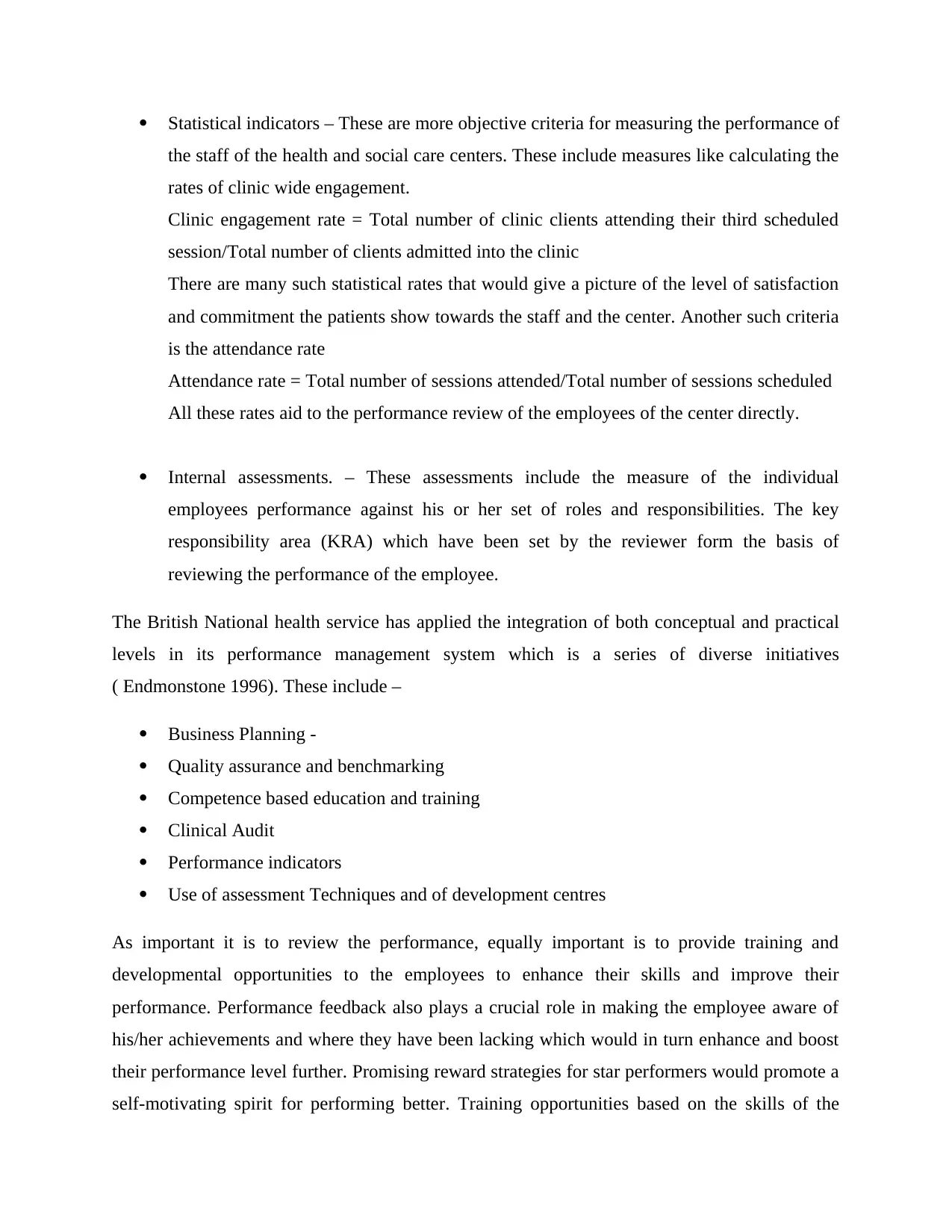
Statistical indicators – These are more objective criteria for measuring the performance of
the staff of the health and social care centers. These include measures like calculating the
rates of clinic wide engagement.
Clinic engagement rate = Total number of clinic clients attending their third scheduled
session/Total number of clients admitted into the clinic
There are many such statistical rates that would give a picture of the level of satisfaction
and commitment the patients show towards the staff and the center. Another such criteria
is the attendance rate
Attendance rate = Total number of sessions attended/Total number of sessions scheduled
All these rates aid to the performance review of the employees of the center directly.
Internal assessments. – These assessments include the measure of the individual
employees performance against his or her set of roles and responsibilities. The key
responsibility area (KRA) which have been set by the reviewer form the basis of
reviewing the performance of the employee.
The British National health service has applied the integration of both conceptual and practical
levels in its performance management system which is a series of diverse initiatives
( Endmonstone 1996). These include –
Business Planning -
Quality assurance and benchmarking
Competence based education and training
Clinical Audit
Performance indicators
Use of assessment Techniques and of development centres
As important it is to review the performance, equally important is to provide training and
developmental opportunities to the employees to enhance their skills and improve their
performance. Performance feedback also plays a crucial role in making the employee aware of
his/her achievements and where they have been lacking which would in turn enhance and boost
their performance level further. Promising reward strategies for star performers would promote a
self-motivating spirit for performing better. Training opportunities based on the skills of the
the staff of the health and social care centers. These include measures like calculating the
rates of clinic wide engagement.
Clinic engagement rate = Total number of clinic clients attending their third scheduled
session/Total number of clients admitted into the clinic
There are many such statistical rates that would give a picture of the level of satisfaction
and commitment the patients show towards the staff and the center. Another such criteria
is the attendance rate
Attendance rate = Total number of sessions attended/Total number of sessions scheduled
All these rates aid to the performance review of the employees of the center directly.
Internal assessments. – These assessments include the measure of the individual
employees performance against his or her set of roles and responsibilities. The key
responsibility area (KRA) which have been set by the reviewer form the basis of
reviewing the performance of the employee.
The British National health service has applied the integration of both conceptual and practical
levels in its performance management system which is a series of diverse initiatives
( Endmonstone 1996). These include –
Business Planning -
Quality assurance and benchmarking
Competence based education and training
Clinical Audit
Performance indicators
Use of assessment Techniques and of development centres
As important it is to review the performance, equally important is to provide training and
developmental opportunities to the employees to enhance their skills and improve their
performance. Performance feedback also plays a crucial role in making the employee aware of
his/her achievements and where they have been lacking which would in turn enhance and boost
their performance level further. Promising reward strategies for star performers would promote a
self-motivating spirit for performing better. Training opportunities based on the skills of the
Paraphrase This Document
Need a fresh take? Get an instant paraphrase of this document with our AI Paraphraser
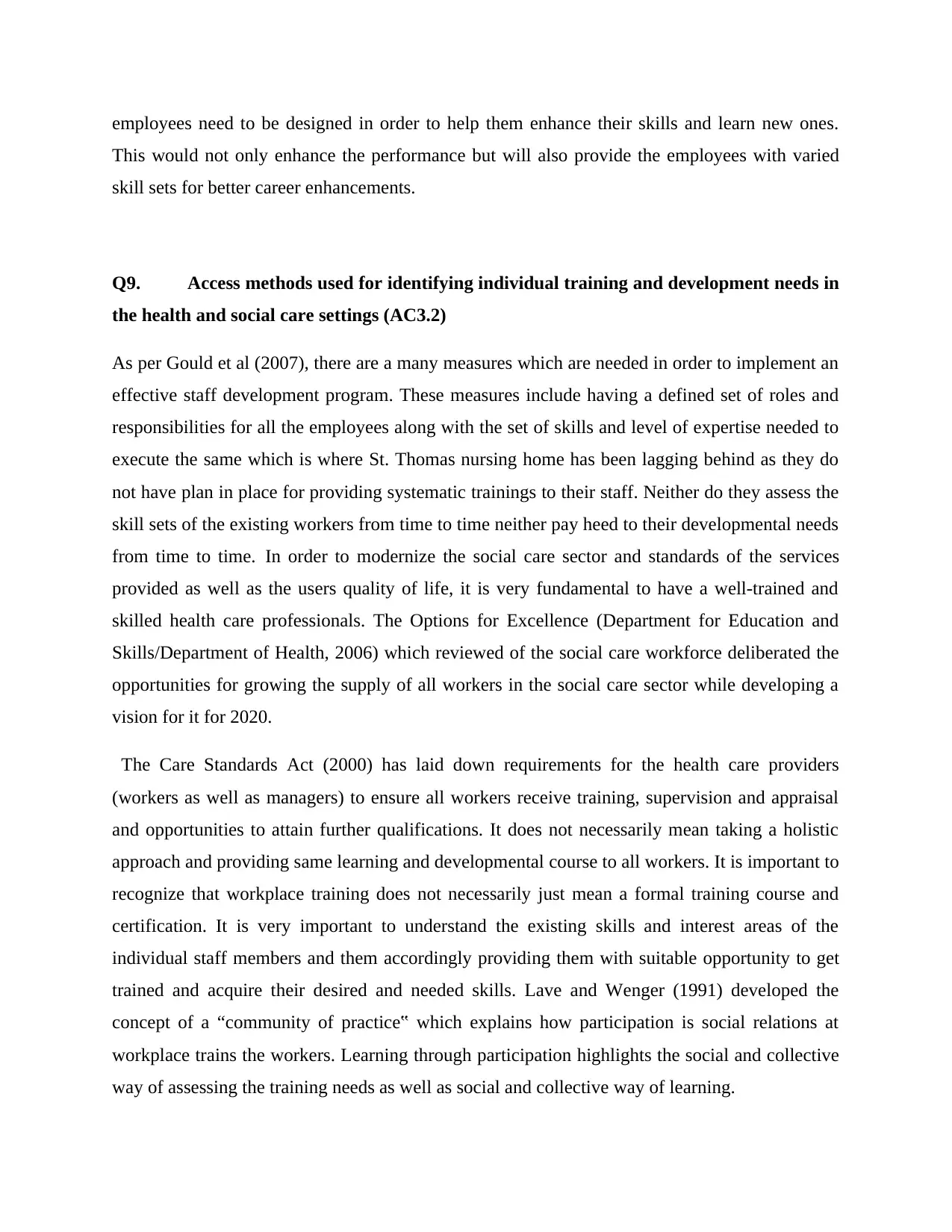
employees need to be designed in order to help them enhance their skills and learn new ones.
This would not only enhance the performance but will also provide the employees with varied
skill sets for better career enhancements.
Q9. Access methods used for identifying individual training and development needs in
the health and social care settings (AC3.2)
As per Gould et al (2007), there are a many measures which are needed in order to implement an
effective staff development program. These measures include having a defined set of roles and
responsibilities for all the employees along with the set of skills and level of expertise needed to
execute the same which is where St. Thomas nursing home has been lagging behind as they do
not have plan in place for providing systematic trainings to their staff. Neither do they assess the
skill sets of the existing workers from time to time neither pay heed to their developmental needs
from time to time. In order to modernize the social care sector and standards of the services
provided as well as the users quality of life, it is very fundamental to have a well-trained and
skilled health care professionals. The Options for Excellence (Department for Education and
Skills/Department of Health, 2006) which reviewed of the social care workforce deliberated the
opportunities for growing the supply of all workers in the social care sector while developing a
vision for it for 2020.
The Care Standards Act (2000) has laid down requirements for the health care providers
(workers as well as managers) to ensure all workers receive training, supervision and appraisal
and opportunities to attain further qualifications. It does not necessarily mean taking a holistic
approach and providing same learning and developmental course to all workers. It is important to
recognize that workplace training does not necessarily just mean a formal training course and
certification. It is very important to understand the existing skills and interest areas of the
individual staff members and them accordingly providing them with suitable opportunity to get
trained and acquire their desired and needed skills. Lave and Wenger (1991) developed the
concept of a “community of practice‟ which explains how participation is social relations at
workplace trains the workers. Learning through participation highlights the social and collective
way of assessing the training needs as well as social and collective way of learning.
This would not only enhance the performance but will also provide the employees with varied
skill sets for better career enhancements.
Q9. Access methods used for identifying individual training and development needs in
the health and social care settings (AC3.2)
As per Gould et al (2007), there are a many measures which are needed in order to implement an
effective staff development program. These measures include having a defined set of roles and
responsibilities for all the employees along with the set of skills and level of expertise needed to
execute the same which is where St. Thomas nursing home has been lagging behind as they do
not have plan in place for providing systematic trainings to their staff. Neither do they assess the
skill sets of the existing workers from time to time neither pay heed to their developmental needs
from time to time. In order to modernize the social care sector and standards of the services
provided as well as the users quality of life, it is very fundamental to have a well-trained and
skilled health care professionals. The Options for Excellence (Department for Education and
Skills/Department of Health, 2006) which reviewed of the social care workforce deliberated the
opportunities for growing the supply of all workers in the social care sector while developing a
vision for it for 2020.
The Care Standards Act (2000) has laid down requirements for the health care providers
(workers as well as managers) to ensure all workers receive training, supervision and appraisal
and opportunities to attain further qualifications. It does not necessarily mean taking a holistic
approach and providing same learning and developmental course to all workers. It is important to
recognize that workplace training does not necessarily just mean a formal training course and
certification. It is very important to understand the existing skills and interest areas of the
individual staff members and them accordingly providing them with suitable opportunity to get
trained and acquire their desired and needed skills. Lave and Wenger (1991) developed the
concept of a “community of practice‟ which explains how participation is social relations at
workplace trains the workers. Learning through participation highlights the social and collective
way of assessing the training needs as well as social and collective way of learning.
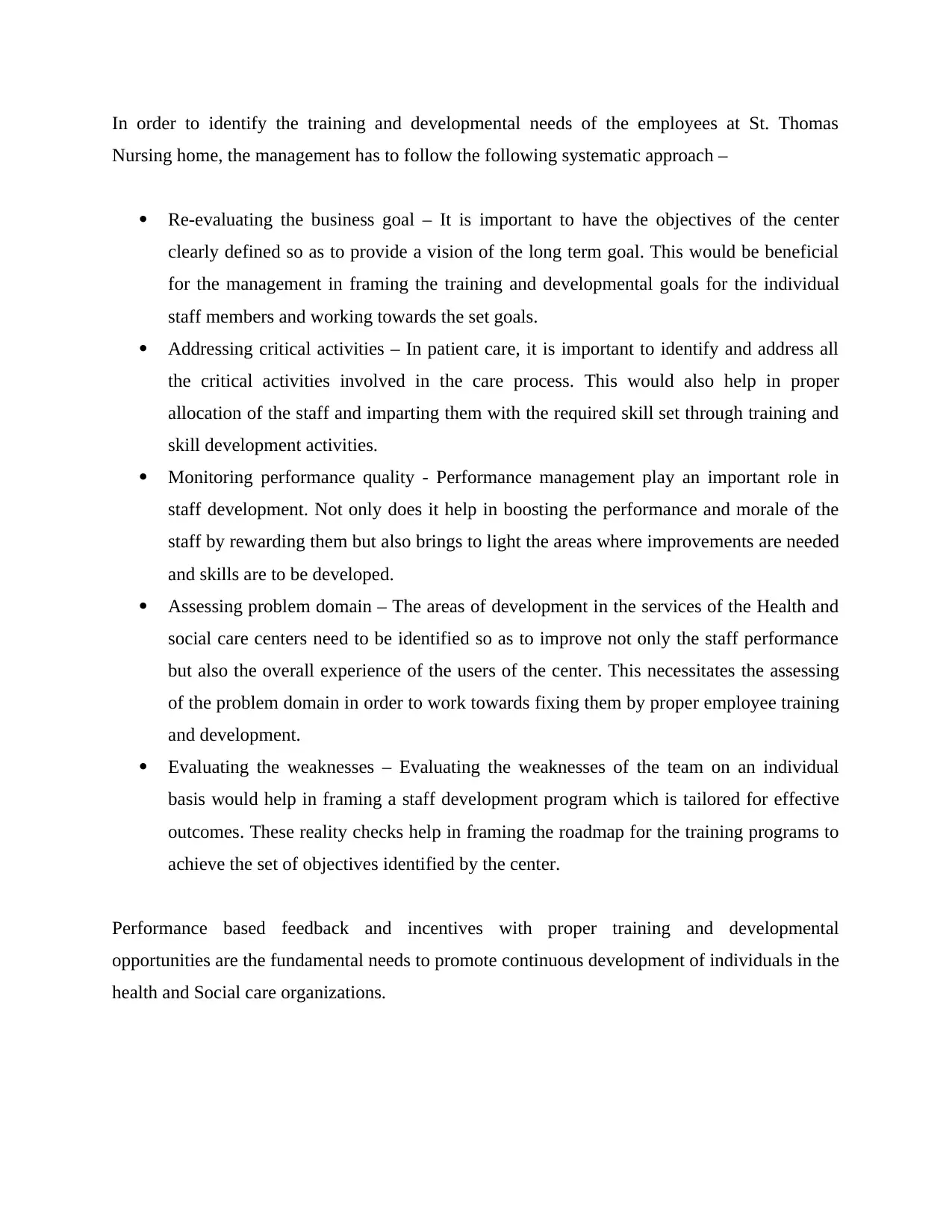
In order to identify the training and developmental needs of the employees at St. Thomas
Nursing home, the management has to follow the following systematic approach –
Re-evaluating the business goal – It is important to have the objectives of the center
clearly defined so as to provide a vision of the long term goal. This would be beneficial
for the management in framing the training and developmental goals for the individual
staff members and working towards the set goals.
Addressing critical activities – In patient care, it is important to identify and address all
the critical activities involved in the care process. This would also help in proper
allocation of the staff and imparting them with the required skill set through training and
skill development activities.
Monitoring performance quality - Performance management play an important role in
staff development. Not only does it help in boosting the performance and morale of the
staff by rewarding them but also brings to light the areas where improvements are needed
and skills are to be developed.
Assessing problem domain – The areas of development in the services of the Health and
social care centers need to be identified so as to improve not only the staff performance
but also the overall experience of the users of the center. This necessitates the assessing
of the problem domain in order to work towards fixing them by proper employee training
and development.
Evaluating the weaknesses – Evaluating the weaknesses of the team on an individual
basis would help in framing a staff development program which is tailored for effective
outcomes. These reality checks help in framing the roadmap for the training programs to
achieve the set of objectives identified by the center.
Performance based feedback and incentives with proper training and developmental
opportunities are the fundamental needs to promote continuous development of individuals in the
health and Social care organizations.
Nursing home, the management has to follow the following systematic approach –
Re-evaluating the business goal – It is important to have the objectives of the center
clearly defined so as to provide a vision of the long term goal. This would be beneficial
for the management in framing the training and developmental goals for the individual
staff members and working towards the set goals.
Addressing critical activities – In patient care, it is important to identify and address all
the critical activities involved in the care process. This would also help in proper
allocation of the staff and imparting them with the required skill set through training and
skill development activities.
Monitoring performance quality - Performance management play an important role in
staff development. Not only does it help in boosting the performance and morale of the
staff by rewarding them but also brings to light the areas where improvements are needed
and skills are to be developed.
Assessing problem domain – The areas of development in the services of the Health and
social care centers need to be identified so as to improve not only the staff performance
but also the overall experience of the users of the center. This necessitates the assessing
of the problem domain in order to work towards fixing them by proper employee training
and development.
Evaluating the weaknesses – Evaluating the weaknesses of the team on an individual
basis would help in framing a staff development program which is tailored for effective
outcomes. These reality checks help in framing the roadmap for the training programs to
achieve the set of objectives identified by the center.
Performance based feedback and incentives with proper training and developmental
opportunities are the fundamental needs to promote continuous development of individuals in the
health and Social care organizations.
⊘ This is a preview!⊘
Do you want full access?
Subscribe today to unlock all pages.

Trusted by 1+ million students worldwide
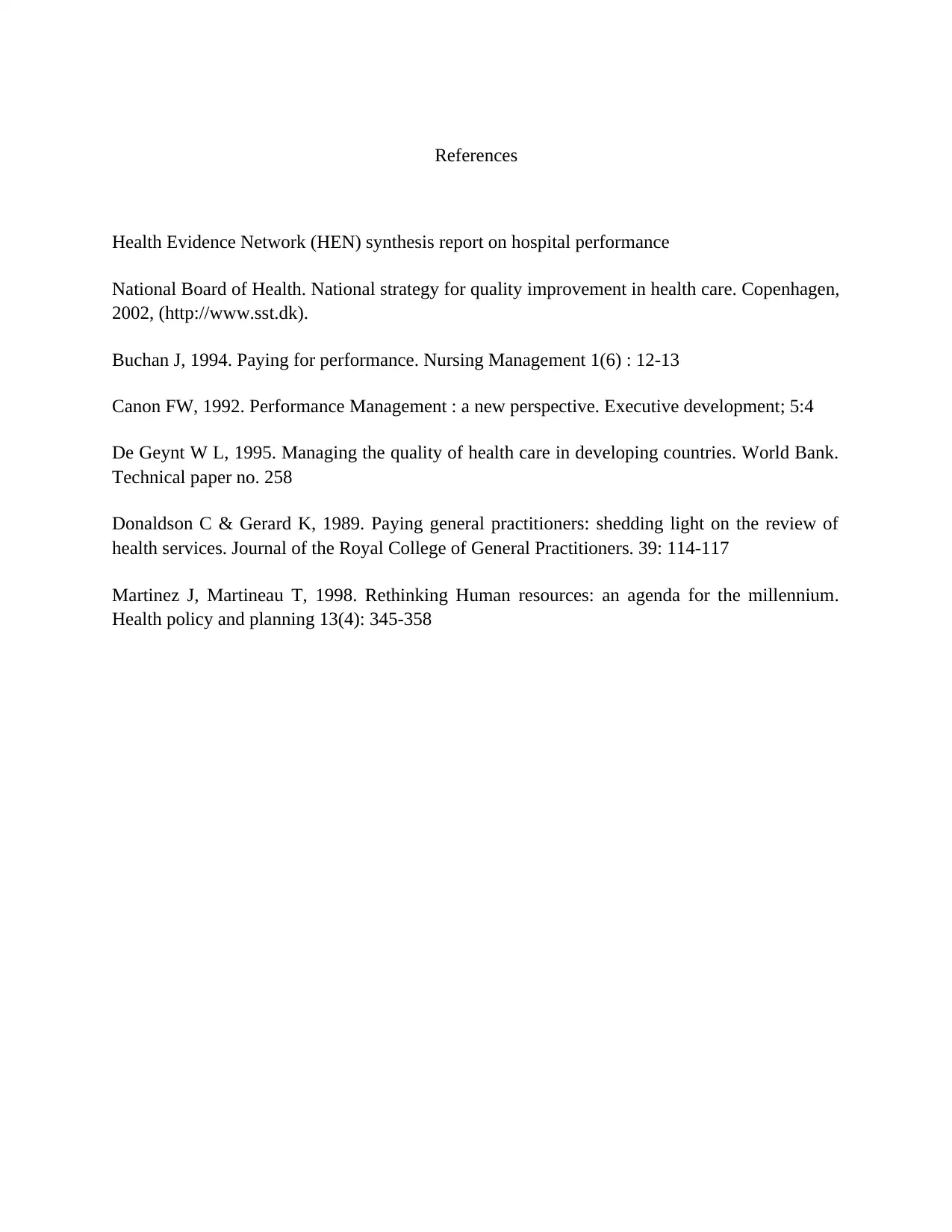
References
Health Evidence Network (HEN) synthesis report on hospital performance
National Board of Health. National strategy for quality improvement in health care. Copenhagen,
2002, (http://www.sst.dk).
Buchan J, 1994. Paying for performance. Nursing Management 1(6) : 12-13
Canon FW, 1992. Performance Management : a new perspective. Executive development; 5:4
De Geynt W L, 1995. Managing the quality of health care in developing countries. World Bank.
Technical paper no. 258
Donaldson C & Gerard K, 1989. Paying general practitioners: shedding light on the review of
health services. Journal of the Royal College of General Practitioners. 39: 114-117
Martinez J, Martineau T, 1998. Rethinking Human resources: an agenda for the millennium.
Health policy and planning 13(4): 345-358
Health Evidence Network (HEN) synthesis report on hospital performance
National Board of Health. National strategy for quality improvement in health care. Copenhagen,
2002, (http://www.sst.dk).
Buchan J, 1994. Paying for performance. Nursing Management 1(6) : 12-13
Canon FW, 1992. Performance Management : a new perspective. Executive development; 5:4
De Geynt W L, 1995. Managing the quality of health care in developing countries. World Bank.
Technical paper no. 258
Donaldson C & Gerard K, 1989. Paying general practitioners: shedding light on the review of
health services. Journal of the Royal College of General Practitioners. 39: 114-117
Martinez J, Martineau T, 1998. Rethinking Human resources: an agenda for the millennium.
Health policy and planning 13(4): 345-358
1 out of 7
Related Documents
Your All-in-One AI-Powered Toolkit for Academic Success.
+13062052269
info@desklib.com
Available 24*7 on WhatsApp / Email
![[object Object]](/_next/static/media/star-bottom.7253800d.svg)
Unlock your academic potential
Copyright © 2020–2025 A2Z Services. All Rights Reserved. Developed and managed by ZUCOL.





